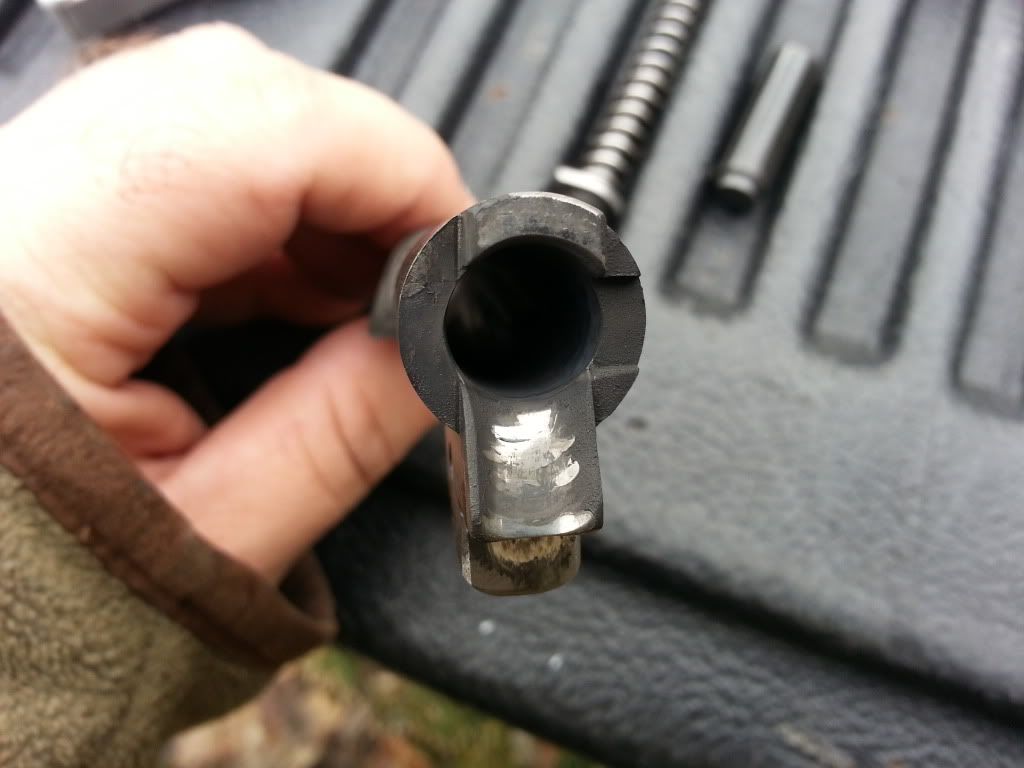Objective: begin dispelling myths and misconceptions about short recoil operated pistols, and 1911s in particular.
Requests from the Author: Please do not quote authorities of the 1911 out of context. If they care to chime in, great. Chances are they are simplifying an observation and quoting them will not do justice to their insight. Please don’t simply say “my experience with 1911s has been poor.” It adds nothing to the discussion. In other words, I’m going to spend more than a few “unbilled” hours on this, so please don’t turn it into every other 1911 thread out there.
I stated previously that for Browning Tilt Barrel Short Recoil Operated pistols, the magazine is the primary concern. For background, and to dispel Myth 1 (1911s have a more torturous feed path), please consider the following pictures. Picture 1 is of a Sig P220 with current generation magazines.
Picture 1. Sig P220 Feeding Angle
Notice the nearly horizontal angle of the round in the magazine. I don’t believe anyone will argue that the P220 isn’t a reliable design and I’ve never heard anyone say it had a difficult feed path or that it was the “King of the Feedway Stoppage.” Now let us take a look at a Colt. First up, in Picture 2, a typical 7 round magazine with tapered feed lips.
Picture 2. Colt S70 of Recent Manufacture and a 7 Round Magazine of Recent Manufacture
Now it seems appropriate to look at a more modern magazine. In Picture 3, a Wilson ETM is shown in the same Colt S70.
Picture 3. Colt S70 of Recent Manufacture and an 8 Round Wilson Combat ETM Magazine
Obviously, there is no indication in these pictures of a more tortuous feed path when compared with a Sig P220. There does exist a distinct and significant difference between a P220 mag and even an ETM mag. For the sake of argument, lets carry this line a bit further before broaching that difference. In Picture 4, the “Benchmark of Modern Design and Reliability” – a 3rd Generation G17 with a factory magazine.
Picture 4. 3rd Gen G17 with Factory 17rd Magazine
I don’t believe that to be a significant improvement in cartridge position over the 7 round 1911 combination, but that begs the question – What is significant? Picture 5 is of a “Short Extractor” P226 Elite Dark, using factory (MecGar) magazines.
Picture 5. Sig P226 Elite Dark with Factory Magazine
Picture 5 shows similar position relative to the chamber as the G17 in Picture 4. Picture 6 shows a MkIII P35 with a factory (MecGar) 13rnd magazine.
Picture 6. MkIII P35 with Factory 13rd Magazine.
Finally, Picture 7 shows a Beretta M9A1 with the new PVD coated magazine.
Picture 7. Beretta M9A1 with PVD Coated Factory Magazine.
As can be seen, the largest departures of magazine position to chamber position are with the P220 and the M9A1, both highly regarded for reliability. By logical conclusion, another factor(s) is at play.
First, let us see if we can agree on a principal of mechanical reliability. That is reliability a function of consistency. If the ammunition is identical round to round, the firearms operation (excepting the magazine) identical round to round, the firearm is held the same, then reliability must stem from the magazine. That is not to say reliability is a function of the magazine and magazine alone, but we must understand the components before the system. In that light, it seems appropriate to look for indications of variation in how the round is presented to the feedramp/chamber. Picture 8 shows the feedramp of a 10mm Nighthawk Custom Falcon using the factory 8 round magazine (Checkmate welded base) and fresh recoil spring and Hornady 155gr factory loads.
Picture 8. NHC Falcon in 10mm Feedramp Markings
Inspection of the feedramp indications inconsistent presentation of the round. The firearm to date has been reliable. Figure 9 shows the feedramp of a Springfield Armory Professional Model of recent manufacture using “tuned” Wilson ETM magazines and 200gr LSWC ammunition.
Picture 9. SACS Professional Model with Tuned ETM 8rd Magazine
As can be seen in Picture 9, a much more consistent, higher in position to the bore centerline mark can be seen. To investigate this further, 4 Wilson ETM 8rd magazines were modified with new followers, base plates, and springs (springs were stock, but tuned to modify the load distribution on the followers). The result is shown in Figure 10.
Picture 10. Wilson CQB (WCOO range) using Modified ETM Magazines.
As can be seen in the Picture 10, nearly no contact with the feedramp is indicated. Picture 11 shows the same magazines used in the S70 Colt from above.














 Reply With Quote
Reply With Quote





